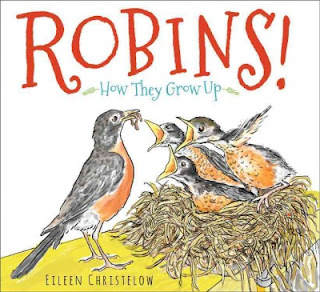I've never really thought of Christelow as a nonfiction author, but her picture book expertise translates well to this narrative nonfiction title.
The first spread introduces a pair of teenage robins who are here to tell us their story. The story is told through panels of art, dialogue between the two immature robins (complete with speech bubbles), and paragraphs of text. It begins with the male robin's migration north, glosses lightly over mating, and jumps into nest-building and eggs. The robins' choice of a nesting spot on top of a hoe is taken from Christelow's own experience (explained later in the back matter). The robins guard and protect their eggs, although one is lost to a hungry squirrel, and later care for their hatchlings. The baby birds grow from hideous, featherless creatures (I am not one of those who likes baby birds. Ugh.) to fledglings ready to fly. Along the way, one of the three falls prey to a hungry hawk. The two remaining birds, teh ones telling the story, continue to explain their growth and development, learning to live with the flock, and beginning to care for themselves as their parents prepare to raise another family. The story ends as the robins migrate south with their flock for the first time.
Christelow writes an author's note about her experience with robins and encourages readers to observe their own backyards for wildlife and seasonal changes. The book also includes a glossary, more facts about robins, and a short list of sources.
It can sometimes be hard to find solid titles on "ordinary" animals. For my audience in Wisconsin, robins are a common bird that many kids are likely to see about in the spring and summer. This book is an excellent resource for encouraging kids to explore their local wildlife, learn simple facts about bird life cycles, and hone their observation skills. Although the text can be lengthy in parts, the illustration panels tell their own story that younger children can easily follow while older readers and classes will find much to explore.
Verdict: An excellent resource, not to be missed. Recommended.
ISBN: 9780544442894; Published 2017 by Clarion; Purchased for the library
The first spread introduces a pair of teenage robins who are here to tell us their story. The story is told through panels of art, dialogue between the two immature robins (complete with speech bubbles), and paragraphs of text. It begins with the male robin's migration north, glosses lightly over mating, and jumps into nest-building and eggs. The robins' choice of a nesting spot on top of a hoe is taken from Christelow's own experience (explained later in the back matter). The robins guard and protect their eggs, although one is lost to a hungry squirrel, and later care for their hatchlings. The baby birds grow from hideous, featherless creatures (I am not one of those who likes baby birds. Ugh.) to fledglings ready to fly. Along the way, one of the three falls prey to a hungry hawk. The two remaining birds, teh ones telling the story, continue to explain their growth and development, learning to live with the flock, and beginning to care for themselves as their parents prepare to raise another family. The story ends as the robins migrate south with their flock for the first time.
Christelow writes an author's note about her experience with robins and encourages readers to observe their own backyards for wildlife and seasonal changes. The book also includes a glossary, more facts about robins, and a short list of sources.
It can sometimes be hard to find solid titles on "ordinary" animals. For my audience in Wisconsin, robins are a common bird that many kids are likely to see about in the spring and summer. This book is an excellent resource for encouraging kids to explore their local wildlife, learn simple facts about bird life cycles, and hone their observation skills. Although the text can be lengthy in parts, the illustration panels tell their own story that younger children can easily follow while older readers and classes will find much to explore.
Verdict: An excellent resource, not to be missed. Recommended.
ISBN: 9780544442894; Published 2017 by Clarion; Purchased for the library

No comments:
Post a Comment